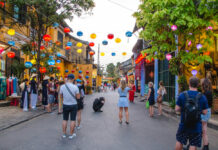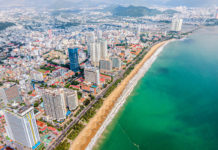Traveling through Vietnam by train is a unique and immersive experience that allows you to witness the breathtaking landscapes of this diverse country. From the bustling cities of the north to the lush tropical regions of the south, the Vietnamese railway system offers a comfortable and convenient way to explore the country’s rich culture and history. In this comprehensive guide, we’ll delve into the world of train travel in Vietnam, covering everything from seat and berth options to the most popular routes and practical tips to ensure a smooth and unforgettable journey.
Why travel by train through Vietnam
Traveling by train in Vietnam offers a distinct advantage over other modes of transportation. The railway system connects many of the country’s major cities and tourist destinations, providing a comfortable and scenic way to experience the diverse landscapes and cultural tapestry of the nation. Unlike crowded buses or long drives, train travel allows you to sit back, relax, and immerse yourself in the ever-changing scenery as you glide through the countryside.
Scenic routes and stunning landscapes
One of the primary reasons to choose train travel in Vietnam is the opportunity to witness the country’s breathtaking natural beauty. The Vietnamese railway system traverses a wide range of landscapes, from the lush, verdant rice fields of the Mekong Delta to the rugged, mountainous regions of the north. As you journey through the countryside, you’ll be treated to panoramic views of towering peaks, winding rivers, and picturesque villages, offering a unique perspective on the country that you simply can’t get from a plane or a bus.
Cultural immersion and interaction
Traveling by train in Vietnam also provides a unique opportunity for cultural immersion and interaction with local residents. As you share the carriage with Vietnamese passengers, you’ll have the chance to engage in conversations, observe daily life, and gain a deeper understanding of the country’s customs and traditions. This intimate experience can be particularly rewarding for travelers seeking to connect with the local culture and create meaningful connections during their journey.
Convenience and comfort
In addition to the scenic and cultural benefits, train travel in Vietnam offers a high level of convenience and comfort compared to other transportation options. The railway system is well-developed, with a variety of train classes and seating options to suit different budgets and preferences. Whether you’re looking for a budget-friendly ride or a more luxurious experience, the Vietnamese trains provide a comfortable and reliable way to navigate the country.
What is traveling by train in Vietnam like?
Traveling by train in Vietnam is a unique and immersive experience that offers a glimpse into the daily lives of the local population. From the bustling train stations to the rhythmic sounds of the rails, the journey itself is an integral part of the adventure.
Bustling train stations
Train stations in Vietnam are hubs of activity, with vendors selling a variety of local snacks and souvenirs, and passengers bustling to and fro. As you arrive at a station, you’ll be greeted by the cacophony of voices, the honking of horns, and the general sense of excitement and anticipation. This lively atmosphere sets the tone for your train journey and provides a glimpse into the vibrant culture of the country.
Onboard experience
Once aboard the train, you’ll be struck by the diverse mix of passengers, from local commuters to long-distance travelers. The carriages are often a reflection of the country’s social fabric, with people of all ages and backgrounds sharing the space. As the train departs, you’ll be lulled by the rhythmic clacking of the wheels, the gentle sway of the carriage, and the ever-changing landscape outside your window.
Interaction with locals
One of the most rewarding aspects of train travel in Vietnam is the opportunity to interact with local passengers. Whether it’s a friendly conversation, a shared meal, or a simple exchange of smiles, these interactions can provide valuable insights into the Vietnamese way of life. Keep in mind that while most locals are eager to engage with foreign travelers, it’s important to respect their personal space and boundaries.
Onboard amenities and services
The level of amenities and services on Vietnamese trains can vary depending on the class of travel and the route. However, even the most basic trains typically offer comfortable seating, air conditioning, and basic food and beverage options. Higher-class trains may include additional features such as sleeper berths, dining cars, and even Wi-Fi connectivity. Be sure to research the specific amenities offered on your chosen route to ensure a comfortable and enjoyable journey.
Seats and Berths
When it comes to seating options on Vietnamese trains, travelers have a range of choices to suit their preferences and budget. From basic hard seats to luxurious sleeping berths, the railway system offers a variety of accommodations to cater to different traveler needs.
Hard seats
The most basic and budget-friendly seating option on Vietnamese trains is the hard seat. These are simple, no-frills wooden or plastic benches that provide a basic level of comfort for shorter journeys. While not the most luxurious option, hard seats are a popular choice for local commuters and budget-conscious travelers.
Soft seats
For a slightly more comfortable experience, travelers can opt for soft seats. These seats are upholstered and often recline to provide a more relaxed and cushioned ride. Soft seats are a popular choice for medium-length journeys, as they offer a step up in comfort while still maintaining affordability.
Sleeper berths
For longer-distance journeys or overnight travel, Vietnamese trains offer sleeper berths as an accommodation option. These berths come in various configurations, including hard sleepers (6 berths per compartment) and soft sleepers (4 berths per compartment). Soft sleepers generally provide a more comfortable and private experience, with wider berths and a bit more space.
Luxury options
For those seeking a truly premium train travel experience, some routes offer luxury options, such as private cabins or first-class seating. These high-end accommodations feature amenities like en-suite bathrooms, dining services, and enhanced privacy and comfort. While more expensive, these luxury options can be a tempting choice for travelers seeking a truly indulgent journey.
Regardless of the seating or berth option you choose, it’s important to book your tickets well in advance, especially during peak travel seasons, to ensure availability and secure your preferred class of travel.
Train times
The train schedule in Vietnam is generally reliable, with trains running on a consistent timetable. However, it’s important to note that delays can sometimes occur due to a variety of factors, such as weather conditions, maintenance, or unexpected events.
Frequency of trains
The frequency of train departures can vary depending on the route and the time of day. Major routes, such as the Hanoi to Ho Chi Minh City line, typically have multiple train options throughout the day, with departures every few hours. On the other hand, less-traveled routes may have fewer daily train options, with longer intervals between departures.
Journey times
The duration of train journeys in Vietnam can range from a few hours for shorter routes to over 30 hours for longer-distance trips. For example, the journey from Hanoi to Ho Chi Minh City can take approximately 30-35 hours, while the trip from Hanoi to Sapa in the north may only take around 4-5 hours.
Punctuality and delays
While Vietnamese trains generally adhere to their published schedules, delays can occasionally occur. These delays can be caused by a variety of factors, such as inclement weather, track maintenance, or unexpected operational issues. It’s always a good idea to build in some buffer time when planning your train travel to account for potential delays and ensure a smooth connection to your next destination.
Night trains
Many long-distance train routes in Vietnam offer overnight options, allowing travelers to cover substantial distances while they sleep. These night trains are popular for their convenience and the opportunity to maximize the time spent exploring destinations. However, it’s important to note that the quality of sleep on night trains can vary, depending on the class of travel and the personal preferences of the traveler.
Staying informed about the train schedule and being prepared for potential delays can help ensure a more seamless and enjoyable train travel experience in Vietnam.
Train stations in Vietnam
The train stations in Vietnam are an integral part of the country’s transportation network, serving as hubs for both local and long-distance travel. These stations vary in size, amenities, and level of activity, but they all play a crucial role in facilitating the movement of people and goods across the country.
Major train stations
The largest and busiest train stations in Vietnam are typically found in the country’s major cities, such as Hanoi, Ho Chi Minh City, Da Nang, and Nha Trang. These stations are often bustling with activity, with a wide range of facilities and services to cater to the needs of travelers.
Smaller regional stations
While the major train stations are the most well-known, Vietnam also has a network of smaller, regional stations that serve local communities and connect them to the broader railway system. These stations may have fewer amenities and a more modest scale, but they still play a vital role in the lives of the people who rely on them for transportation.
Station amenities and facilities
The amenities and facilities available at Vietnamese train stations can vary, but many of the larger stations offer a range of services to accommodate travelers. These may include waiting areas, ticketing offices, luggage storage, and basic dining and refreshment options. Some stations also have connections to other modes of transportation, such as buses or taxis, making it easier for travelers to navigate their onward journeys.
Station atmosphere and culture
Visiting a train station in Vietnam is an immersive cultural experience in itself. The bustling atmosphere, the mix of local and foreign travelers, and the array of sights, sounds, and smells can all contribute to a unique and memorable encounter. Observing the daily routines and interactions of the station’s patrons can provide valuable insights into the local way of life.
Familiarizing yourself with the layout and amenities of the train stations you’ll be using can help you navigate your journey more efficiently and make the most of your train travel experience in Vietnam.
How to get your train tickets
Purchasing train tickets in Vietnam can be a straightforward process, but it’s important to plan ahead and be aware of the various options available to ensure a smooth and stress-free experience.
Online booking
One of the most convenient ways to purchase train tickets in Vietnam is through online booking platforms. Several reputable websites, such as bookaway.com and 12go.asia, offer the ability to search for routes, check availability, and book tickets in advance. This method is particularly useful for travelers who want to secure their seats well ahead of their travel dates.
Directly at the station
Another option is to purchase train tickets directly at the station. This can be a more spontaneous and flexible approach, as it allows you to book your tickets on shorter notice. However, it’s important to note that popular routes and peak travel periods may sell out quickly, so it’s generally advisable to book in advance whenever possible.
Travel agencies
Many travel agencies in Vietnam also offer train ticket booking services. These agencies can be particularly helpful for travelers who prefer the convenience of having a local expert handle the logistics of their train travel. Travel agencies may also be able to provide additional services, such as accommodation and tour packages, to complement your train journey.
Ticket prices and classes
The cost of train tickets in Vietnam can vary depending on the class of travel, the route, and the time of year. Generally, the higher the class of service, the more expensive the ticket. It’s worth doing some research to compare prices and find the option that best fits your budget and travel needs.
Advance booking and flexibility
Regardless of the booking method you choose, it’s recommended to purchase your train tickets as early as possible, especially during peak travel seasons. This will increase your chances of securing your preferred class of travel and avoid the risk of sold-out trains. Additionally, maintaining some flexibility in your travel plans can be beneficial, as it may allow you to take advantage of last-minute deals or alternative route options.
The most popular train routes in Vietnam
Vietnam’s extensive railway network connects many of the country’s most popular destinations, allowing travelers to experience a diverse range of landscapes and cultural attractions. Here are some of the most popular train routes in Vietnam:
Hanoi to Ho Chi Minh City
The Reunification Express, which runs between Hanoi and Ho Chi Minh City, is one of the most well-known and traveled routes in Vietnam. This approximately 30-35 hour journey takes passengers through the heart of the country, offering stunning views of the countryside, mountains, and coastal regions along the way.
Hanoi to Sapa
The train from Hanoi to Sapa, a picturesque mountain town in the north, is a popular choice for those seeking cooler temperatures and breathtaking scenery. The trip takes around 4-5 hours, with the train winding through the lush, terraced rice fields and towering peaks of the Hoang Lien Son mountain range.
Danang to Hue
The route between Danang and Hue, two of Vietnam’s most historic cities, takes travelers through the stunning Hai Van Pass, a scenic coastal mountain pass that offers panoramic views of the East Sea. This approximately 2-hour journey is a favorite among those interested in the country’s rich cultural heritage.
Nha Trang to Da Lat
The train from Nha Trang, a popular beach destination, to Da Lat, a charming highland town, is a scenic and comfortable way to explore the diverse landscapes of central Vietnam. The journey, which takes around 4 hours, showcases the transition from coastal regions to lush, mountainous terrain.
Saigon to Can Tho
For those interested in the vibrant Mekong Delta region, the train from Ho Chi Minh City (Saigon) to Can Tho is a popular choice. This approximately 3-hour journey offers a glimpse into the lush, verdant landscapes and traditional way of life in the Mekong Delta.
Regardless of which route you choose, train travel in Vietnam promises an unforgettable experience, allowing you to immerse yourself in the country’s stunning natural beauty and rich cultural tapestry.
What you should know as you consider a train trip in Vietnam
As you plan your train travel in Vietnam, there are a few key considerations and tips to keep in mind to ensure a smooth and enjoyable journey.
Booking in advance
One of the most important things to remember is to book your train tickets well in advance, especially during peak travel seasons. Popular routes and classes can sell out quickly, so it’s best to secure your seats as early as possible.
Choosing the right class
When booking your train tickets, take the time to research the different class options and choose the one that best suits your budget and travel needs. The amenities and level of comfort can vary significantly between classes, so it’s important to make an informed decision.
Packing essentials
Make sure to pack the essentials for your train journey, such as a small backpack or day bag, snacks and water, a power bank for your devices, and any necessary medications. Additionally, consider bringing a small travel pillow or blanket to make your ride more comfortable, especially if you’re taking an overnight train.
Navigating the stations
Familiarize yourself with the layout and signage of the train stations you’ll be using, as this can help you navigate more efficiently and locate your platform or ticket office. Don’t be afraid to ask for assistance from station staff or fellow passengers if you’re unsure of where to go.
Staying safe and vigilant
While train travel in Vietnam is generally safe, it’s always important to be aware of your surroundings and take basic precautions, such as keeping your valuables secure and being mindful of your belongings, especially in crowded areas.
Embracing the cultural experience
Finally, remember to embrace the cultural experience of train travel in Vietnam. Engage with local passengers, observe the daily routines and interactions, and immerse yourself in the sights, sounds, and flavors of the journey. This open-minded approach will help you create lasting memories and a deeper connection to the country.
Safety and Security
Safety and security are important considerations for any traveler, and train travel in Vietnam is no exception. While the country is generally safe for tourists, it’s always wise to take some basic precautions to ensure a secure and worry-free journey.
Luggage and belongings
One of the primary concerns when traveling by train in Vietnam is the security of your luggage and personal belongings. It’s important to keep a close eye on your bags, especially in crowded areas and during boarding and disembarking. Consider using a small, lightweight backpack or day bag that you can keep with you at all times, rather than checking large suitcases.
Onboard security
The Vietnamese railway system has measures in place to ensure the safety of passengers, such as security checks at the station entrances and the presence of train staff throughout the journey. However, it’s still important to remain vigilant and be aware of your surroundings, particularly in the evenings or on longer-distance trains.
Avoiding scams and theft
As with any tourist destination, it’s essential to be cautious of potential scams and theft when traveling by train in Vietnam. Be wary of anyone who approaches you offering unsolicited assistance or services, and keep your valuables well-hidden and secure. If you do encounter any suspicious activity, report it to the train staff or local authorities.
Emergency preparedness
While major incidents are rare, it’s a good idea to familiarize yourself with the emergency procedures and contact information for the train staff and local authorities. Make sure to have your travel insurance details and emergency contact information readily available in case of any unexpected events during your journey.
By taking a few simple precautions and remaining vigilant, you can enjoy a safe and secure train travel experience in Vietnam, allowing youto focus on the beauty of the landscapes and the cultural richness of the country.
Medical considerations
Before embarking on a train journey in Vietnam, it’s essential to consider any medical needs or concerns you may have. Make sure to pack any necessary medications, including motion sickness remedies if you’re prone to travel sickness. It’s also a good idea to carry a basic first aid kit with essentials like bandages, antiseptic wipes, and pain relievers.
Hygiene and sanitation
While train travel in Vietnam is generally clean and comfortable, it’s still important to prioritize hygiene and sanitation during your journey. Pack hand sanitizer or antibacterial wipes to keep your hands clean, especially before eating, and consider bringing your own reusable water bottle to stay hydrated throughout the trip.
Language barriers
Vietnamese is the official language of Vietnam, so it’s helpful to learn a few basic phrases or carry a translation app to facilitate communication during your train travels. While many train staff and fellow passengers may speak some English, having a few key words and phrases at your disposal can enhance your overall experience and interactions.
Cultural etiquette
As a visitor to Vietnam, it’s important to respect the local customs and cultural norms, especially when traveling on public transportation like trains. Be mindful of personal space, avoid loud or disruptive behavior, and always ask for permission before taking photos of individuals or religious sites. By demonstrating cultural sensitivity, you’ll show respect for the country and its people.
Environmental responsibility
Train travel is already a more eco-friendly option compared to other modes of transportation, but you can further reduce your environmental impact by minimizing waste and being conscious of your carbon footprint. Dispose of trash responsibly, opt for reusable items whenever possible, and support local initiatives that promote sustainability in tourism.
Conclusion
Traveling by train in Vietnam offers a unique and immersive way to experience the country’s diverse landscapes, rich history, and vibrant culture. From the bustling streets of Hanoi to the tranquil rice paddies of Sapa, each journey promises unforgettable moments and lasting memories.
By exploring the most popular train routes, understanding the booking process, and embracing the cultural nuances of train travel, you can embark on a rewarding adventure through this captivating Southeast Asian nation. Remember to prioritize safety and security, pack thoughtfully for your journey, and approach each experience with an open heart and mind.
Whether you’re seeking a leisurely ride through the countryside or an overnight sleeper train to a new destination, Vietnam’s railway system offers a convenient and scenic way to explore this dynamic and enchanting country. So, hop aboard, sit back, and let the rhythmic click-clack of the tracks carry you on an unforgettable voyage through the heart of Vietnam.
























